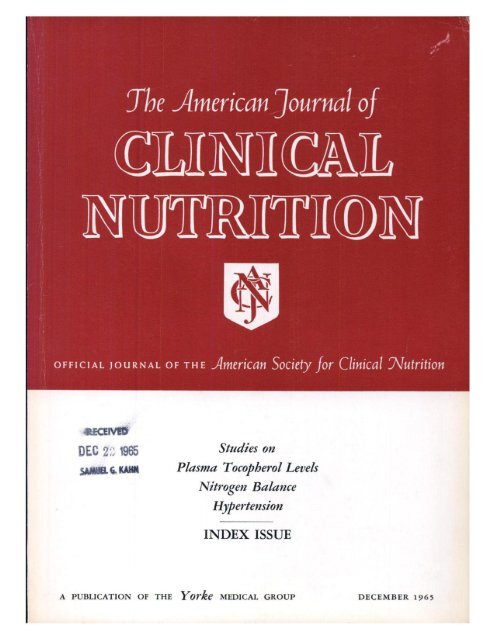母亲产前坚果和海鲜消费与4至15岁儿童神经心理功能:一项基于人群的队列研究
IF 6.5
1区 医学
Q1 NUTRITION & DIETETICS
引用次数: 0
摘要
背景:了解母亲饮食在早期大脑发育中的作用是至关重要的,因为怀孕是大脑发育中一个重要的脆弱和生长时期。目的:考虑到omega-3脂肪酸的潜在中介作用,评估怀孕期间母亲坚果、总海鲜和大脂肪鱼的摄入量与后代长达15年的神经心理功能之间的关系。方法:本研究是西班牙儿童与环境(INMA)出生队列的一部分,追踪了1737对从怀孕到15岁的母子。母亲的饮食使用半定量食物频率问卷进行评估,而儿童的神经心理功能则通过标准化的计算机测试进行测量。注意(击中反应时间及其变异、HRT和HRT- se)采用Conners' Kiddie连续表现测验和注意网络测验进行测量。使用N-back任务评估工作记忆(2-back d2‘和3-back d3’任务的可检测性)。用瑞文渐进矩阵法和初级心理能力测验评估流体智力。线性混合效应回归模型评估了坚果、海鲜和大脂肪鱼与神经心理结果的关联,而广义结构方程模型用于中介分析。结果:较高的母亲坚果摄入量与改善注意力显著相关(HRT-SE β = -0.05, 95%CI = -0.09;-0.00)和工作记忆(d2′β = 0.05, 95%CI = 0.00;0.09, d3′β = 0.06, 95%CI = 0.02;后代0.11)。食用更多的大脂肪鱼与更好的注意力相关(HRT-SE β = -0.06, 95%CI = -0.10;-0.02;HRT β = -0.04, 95%CI = -0.08;-0.00)和流体智力(β = 0.08, 95%CI = 0.02;0.13)。Omega-3脂肪酸介导了8-14%的注意力影响。结论:母亲孕期饮食和摄入omega-3可能支持儿童和青少年的长期认知发展。本文章由计算机程序翻译,如有差异,请以英文原文为准。
Maternal prenatal nut and seafood consumption and child neuropsychological function from 4 to 15 years of age: a population-based cohort study
Background
Understanding the role of maternal diet in early brain development is critical, as pregnancy represents a period of significant vulnerability and growth for the developing brain.
Objectives
This study aims to assess the association between maternal nuts, total seafood, and large fatty fish consumption during pregnancy and offspring neuropsychological function ≤15 y, considering the potential mediation of omega-3 fatty acids.
Methods
This study was part of The Spanish Childhood and Environment birth cohort, following 1737 mother–child pairs from pregnancy to age 15. Maternal diet was evaluated using a semiquantitative food frequency questionnaire, whereas children’s neuropsychological function was measured through standardized computer-based tests. Attention (hit reaction time and its variability, HRT and HRT-SE) was measured with the Conners’ Kiddie Continuous Performance Test and the Attention Network Test. Working memory (detectability in 2-back, d2′, and 3-back tasks, d3′) was evaluated using the N-back task. Fluid intelligence was assessed with Raven’s Progressive Matrices and the Test of Primary Mental Abilities. Linear mixed-effects regression models assessed the association of nuts, seafood and large fatty fish with neuropsychological outcomes, whereas generalized structural equation modeling was used for mediation analyses.
Results
Higher maternal nut consumption was significantly linked to improved attention [HRT-SE β = –0.05, 95% confidence interval (CI): –0.09, –0.00] and working memory (d2′ β = 0.05, 95% CI: 0.00, 0.09, and d3′ β = 0.06, 95% CI: 0.02, 0.11) in offspring. Greater consumption of large fatty fish was associated with better attention (HRT-SE β = –0.06, 95% CI: –0.10, –0.02; and HRT β = –0.04, 95% CI: –0.08, –0.00), and fluid intelligence (β = 0.08, 95% CI: 0.02, 0.13). Omega-3 fatty acids mediated 8%–14% of these effects on attention.
Conclusions
Maternal diet at pregnancy and omega-3 intake may support long-term cognitive development in children and adolescents.
求助全文
通过发布文献求助,成功后即可免费获取论文全文。
去求助
来源期刊
CiteScore
12.40
自引率
4.20%
发文量
332
审稿时长
38 days
期刊介绍:
American Journal of Clinical Nutrition is recognized as the most highly rated peer-reviewed, primary research journal in nutrition and dietetics.It focuses on publishing the latest research on various topics in nutrition, including but not limited to obesity, vitamins and minerals, nutrition and disease, and energy metabolism.
Purpose:
The purpose of AJCN is to:
Publish original research studies relevant to human and clinical nutrition.
Consider well-controlled clinical studies describing scientific mechanisms, efficacy, and safety of dietary interventions in the context of disease prevention or health benefits.
Encourage public health and epidemiologic studies relevant to human nutrition.
Promote innovative investigations of nutritional questions employing epigenetic, genomic, proteomic, and metabolomic approaches.
Include solicited editorials, book reviews, solicited or unsolicited review articles, invited controversy position papers, and letters to the Editor related to prior AJCN articles.
Peer Review Process:
All submitted material with scientific content undergoes peer review by the Editors or their designees before acceptance for publication.

 求助内容:
求助内容: 应助结果提醒方式:
应助结果提醒方式:


